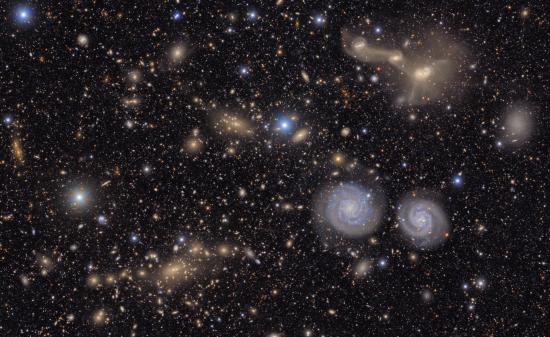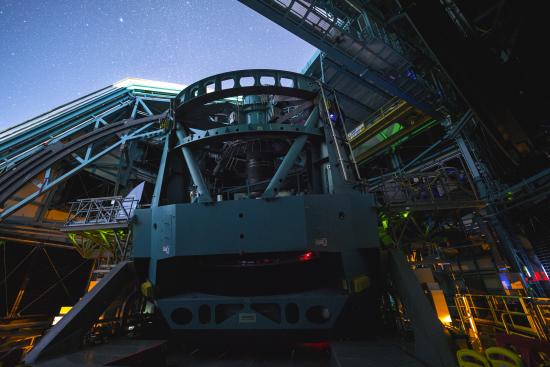June 24, 2025
The University of Tokyo Kavli Institute for the Physics and Mathematics of the Universe (Kavli IPMU, WPI)

The Vera C. Rubin Observatory released its first images taken with the world’s largest digital camera on June 23, 2025 (local time). This marks the beginning of the Legacy Survey of Space and Time (LSST), a large-scale imaging project. Many Japanese researchers, including ones from the University of Tokyo Kavli Institute for the Physics and Mathematics of the Universe (Kavli IPMU, WPI), and the National Astronomical Observatory of Japan (NAOJ), are involved in LSST, and new scientific discoveries are expected through collaboration with the Subaru Telescope.
NSF-DOE Vera C. Rubin Observatory, or simply the Rubin Observatory, is a next-generation astronomical facility led by the United States and located on Cerro Pachón in Chile. Its 8.4-meter optical-infrared telescope, paired with the 3.2-gigapixel LSST Camera, provides the widest field of view ever achieved by a telescope of its class—wide enough to capture an area of the sky equivalent to 45 full moons in a single exposure.
Starting in late 2025, the LSST project will systematically image the entire southern sky (about 20,000 square degrees) in visible to near-infrared wavelengths over a 10-year period. This ambitious survey will collect a massive amount of data and is expected to lead to discoveries across a wide range of fields, including solar system small bodies, galaxies, supernovae, and dark matter.
Japanese researchers are playing key roles in this international project. Japan’s astronomy community has long led the field of wide-field imaging surveys, particularly through Hyper Suprime-Cam (HSC) on the Subaru Telescope. Thanks to their expertise, as well as contributions of Subaru Telescope observing time, Japanese researchers have been recognized as official LSST contributors. Kavli IPMU Professors Naoki Yasuda and Masahiro Takada, and NAOJ Associate Professor Yousuke Utsumi and several other NAOJ researchers leveraged their experience with HSC’s development, operations, and data analysis to support LSST’s success. As a result of these contributions, Japanese researchers have been granted prioritized access to LSST data and have already begun new research in preparation for the survey.
Meanwhile, the Subaru Telescope began operations in 2025 with its new Prime Focus Spectrograph (PFS), a wide-field multi-object spectrograph. With LSST specializing in imaging and Subaru Telescope now equipped with cutting-edge spectroscopic capabilities, this powerful partnership is poised to open new frontiers in astronomy.
"Beginning with photographic plate observations using the Schmidt telescope at the University of Tokyo’s Kiso Observatory, I have been involved in wide-field imaging surveys using instruments including the Kiso Mosaic CCD Camera, the Sloan Digital Sky Survey, and the Subaru Telescope’s Suprime-Cam and Hyper Suprime-Cam.
“Now, the LSST (Legacy Survey of Space and Time), the ultimate survey project, is finally underway. Thanks to major advancements in both hardware and software, we are entering an era where we can get astronomical data of unprecedented precision, covering the widest area, with the highest resolution, and reaching the faintest celestial objects.
“Moreover, by repeatedly observing the same region of the sky over a 10-year period, we expect to detect an exceptionally large number of variable objects. We might discover rare celestial phenomena, and we might also gain new statistical insights into astronomical populations that were previously unclear.
“However, to better understand the true nature of the universe, spectroscopic observations using instruments such as PFS (Prime Focus Spectrograph) will be essential. I look forward to collaborating with the Subaru Telescope to uncover more of the universe’s mysteries," said Yasuda.
Figure 2: One of the first look images released from the Vera C. Rubin Observatory (pan and zoom enabled). This view of the Virgo Cluster covers an area roughly 2.4 times the field of view of the LSST Camera. The image contains about 10 million galaxies, approximately 0.05% of the 20 billion galaxies LSST will capture over the next 10 years. See the original image here, and an annotated version here.(Credit: NSF-DOE Vera C. Rubin Observatory)

Related Links
NAOJ June 24, 2025 Topics
Vera C. Rubin Observatory June 23, 2025 Press Release
Subaru Telescope June 23, 2025 Topics
Kobayashi-Maskawa Institute for the Origin of Particles and the Universe June 24, 2025
Related articles
Prime Focus Spectrograph on Subaru Telescope Is About to Begin Its Scientific Operations (January 10, 2025)
Subaru Telescope's M31 Image Processed by the HSC Data Analysis Software (August 6, 2013)






